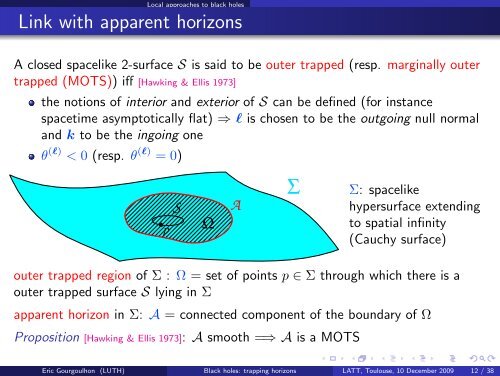Black holes: from event horizons to trapping horizons - LUTH ...
Black holes: from event horizons to trapping horizons - LUTH ...
Black holes: from event horizons to trapping horizons - LUTH ...
You also want an ePaper? Increase the reach of your titles
YUMPU automatically turns print PDFs into web optimized ePapers that Google loves.
Local approaches <strong>to</strong> black <strong>holes</strong><br />
Link with apparent <strong>horizons</strong><br />
A closed spacelike 2-surface S is said <strong>to</strong> be outer trapped (resp. marginally outer<br />
trapped (MOTS)) iff [Hawking & Ellis 1973]<br />
the notions of interior and exterior of S can be defined (for instance<br />
spacetime asymp<strong>to</strong>tically flat) ⇒ ℓ is chosen <strong>to</strong> be the outgoing null normal<br />
and k <strong>to</strong> be the ingoing one<br />
θ (ℓ) < 0 (resp. θ (ℓ) = 0)<br />
Σ: spacelike<br />
hypersurface extending<br />
<strong>to</strong> spatial infinity<br />
(Cauchy surface)<br />
outer trapped region of Σ : Ω = set of points p ∈ Σ through which there is a<br />
outer trapped surface S lying in Σ<br />
apparent horizon in Σ: A = connected component of the boundary of Ω<br />
Proposition [Hawking & Ellis 1973]: A smooth =⇒ A is a MOTS<br />
Eric Gourgoulhon (<strong>LUTH</strong>) <strong>Black</strong> <strong>holes</strong>: <strong>trapping</strong> <strong>horizons</strong> LATT, Toulouse, 10 December 2009 12 / 38
















